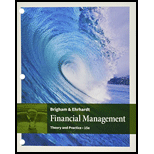
Concept explainers
a.
To calculate: The exercise value of the warrant at different stock prices
a.
Explanation of Solution
(1)
Formula to calculate exercise price:
Substitute $20 for current price and $25 for strike price to calculate the exercise price.
Calculation of exercise price:
Exercise price cannot be negative therefore; the exercise price is $0
(2)
Formula to calculate exercise price:
Substitute $25 for current price and $25 for strike price to calculate the exercise price.
Calculation of exercise price:
Therefore; the exercise price is $0
(3)
Formula to calculate exercise price:
Substitute $30 for current price and $25 for strike price to calculate the exercise price.
Calculation of exercise price:
Therefore; the exercise price is $5
(4)
Formula to calculate exercise price:
Substitute $100 for current price and $25 for strike price to calculate the exercise price.
Calculation of exercise price:
Therefore; the exercise price is $75
b.
To calculate:
The coupon rate and interest amount in dollars attached to the bonds
b.
Explanation of Solution
Formula to calculate
Substitute $1,000 for value of bonds with warrants and number of warrants, 50 and price per warrant $3 to calculate the value of warrants in order to calculate the value of straight bonds.
Calculation of value of straight bonds:
Formula to calculate coupon interest amount:
Substitute $850 for value of straight bonds, 7.4694 for the value of PVIFA at 12% rate for 20 years, $1,000 for value of stock with warrants and 0.1037 for the value of PVIF at 12% rate for 20 years to calculate the coupon interest amount.
Calculation of coupon interest amount:
Therefore, the coupon rate is 9.91% and coupon amount is $9.91 on each bond.
Want to see more full solutions like this?
Chapter 20 Solutions
Bundle: Financial Management: Theory and Practice, Loose-leaf Version, 15th + Aplia, 1 term Printed Access Card
- see itPlease don't answer i posted blurred image mistakely. please comment below i will write values. if you answer with incorrect values i will give unhelpful confirm.arrow_forwardNo use ai. if image is blurr or data is not showing properly then dont answer i will sure deslike. please comment i will write values.arrow_forwardDon't use ai. if image is blurr or data is not showing properly then dont answer i will sure deslike. please comment i will write values.arrow_forward
- no ai Please don't answer i posted blurred image mistakely. please comment below i will write values. if you answer with incorrect values i will give unhelpful confirm.arrow_forwardFinance SubjPlease don't answer i posted blurred image mistakely. please comment below i will write values. if you answer with incorrect values i will give unhelpful confirm.arrow_forwardcalculate ratios for the financial statment given and show all working manually: 3. TIE Ratio 4. Cash Coverage Ratioarrow_forward
- calculate ratios for the financial statment given and show all working manually: 1. Debt Ratios 2. Debt to Equityarrow_forwardcalculate the following ratios for the statements and show all working: 1. Current Ratios 2. Quick Ratio 3. Cash Ratioarrow_forwardDont solve this question with incorrect values. i will give unhelpful . do not solvearrow_forward
 Intermediate Financial Management (MindTap Course...FinanceISBN:9781337395083Author:Eugene F. Brigham, Phillip R. DavesPublisher:Cengage Learning
Intermediate Financial Management (MindTap Course...FinanceISBN:9781337395083Author:Eugene F. Brigham, Phillip R. DavesPublisher:Cengage Learning EBK CONTEMPORARY FINANCIAL MANAGEMENTFinanceISBN:9781337514835Author:MOYERPublisher:CENGAGE LEARNING - CONSIGNMENT
EBK CONTEMPORARY FINANCIAL MANAGEMENTFinanceISBN:9781337514835Author:MOYERPublisher:CENGAGE LEARNING - CONSIGNMENT Financial Reporting, Financial Statement Analysis...FinanceISBN:9781285190907Author:James M. Wahlen, Stephen P. Baginski, Mark BradshawPublisher:Cengage Learning
Financial Reporting, Financial Statement Analysis...FinanceISBN:9781285190907Author:James M. Wahlen, Stephen P. Baginski, Mark BradshawPublisher:Cengage Learning


